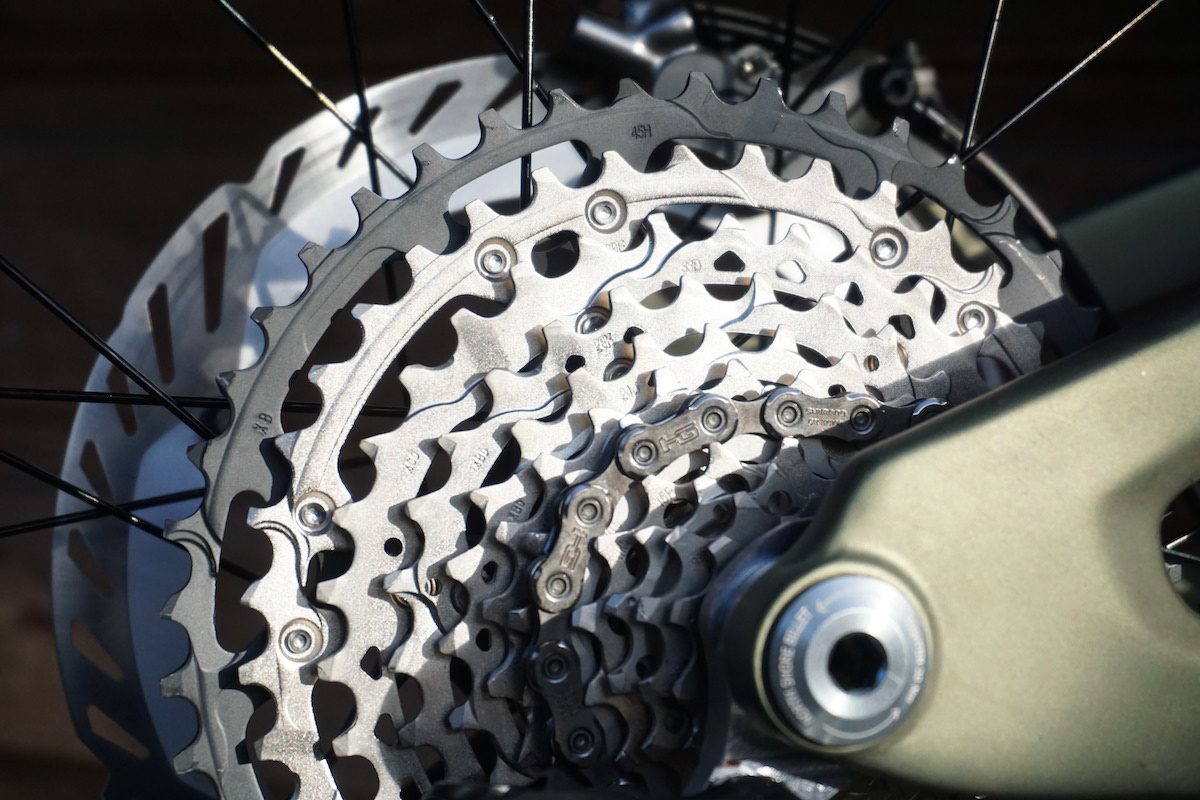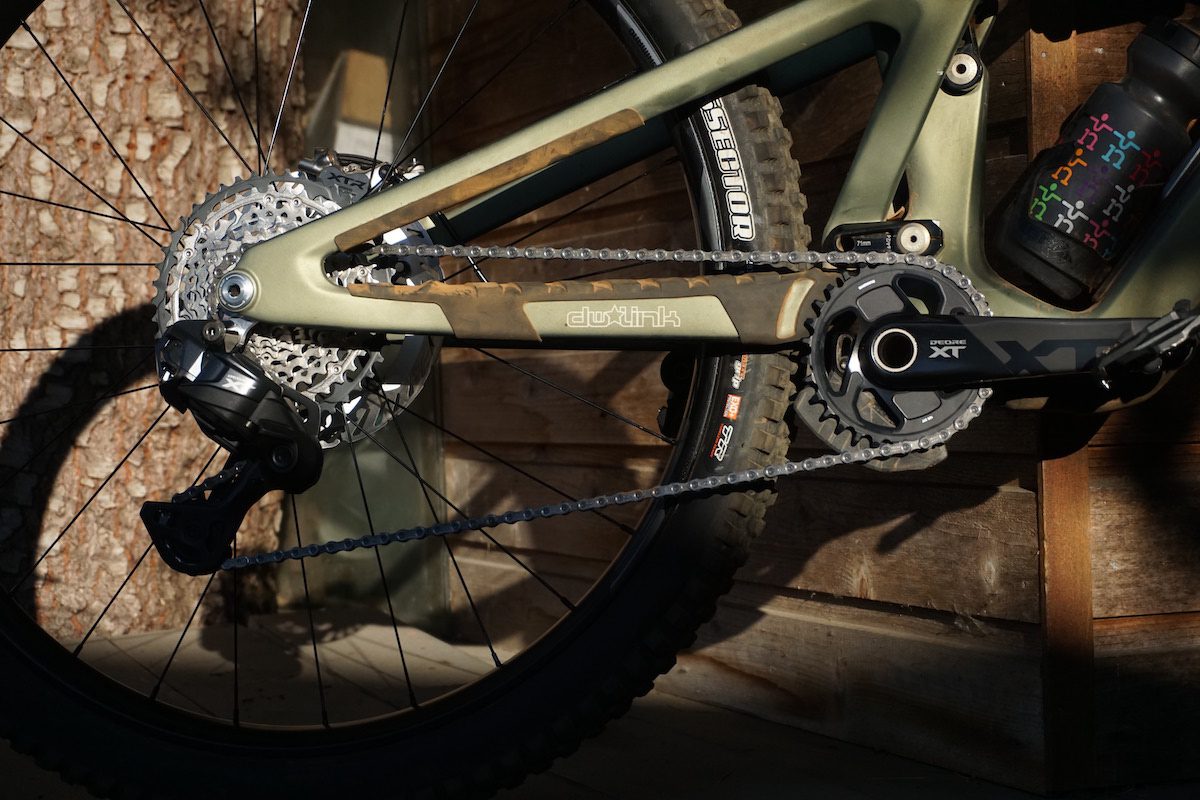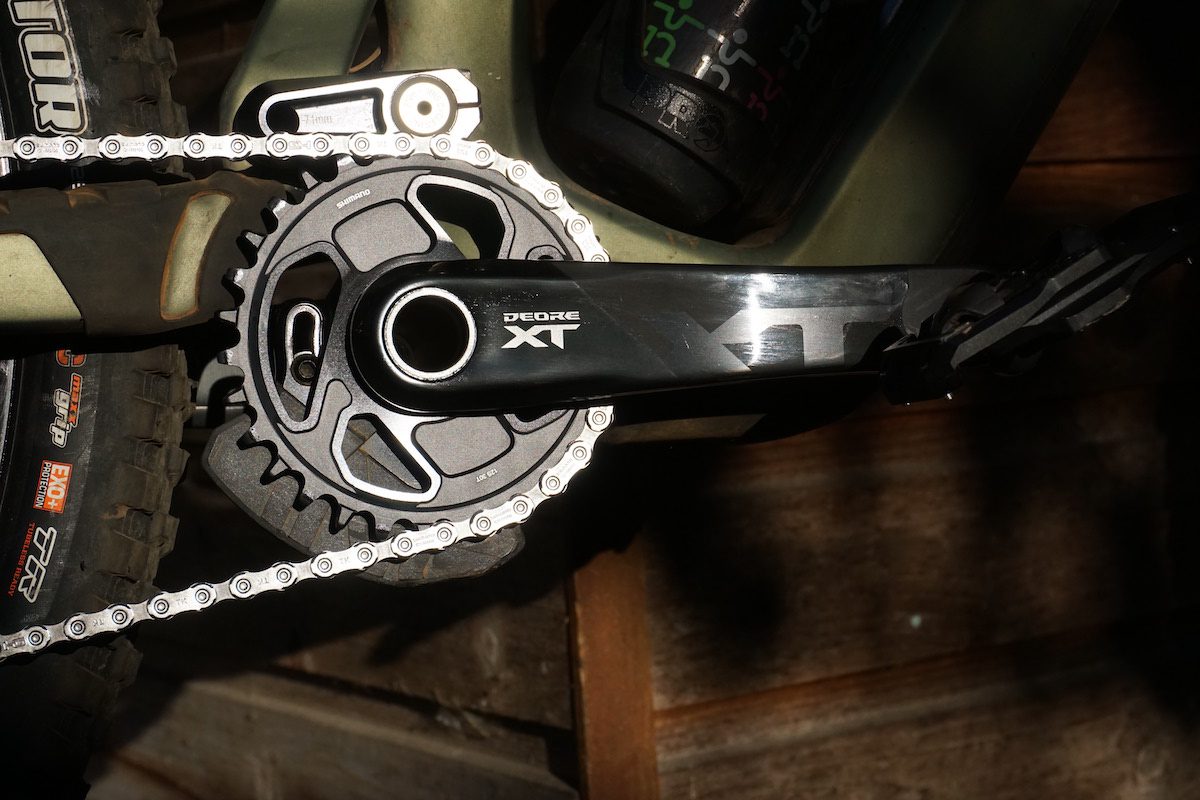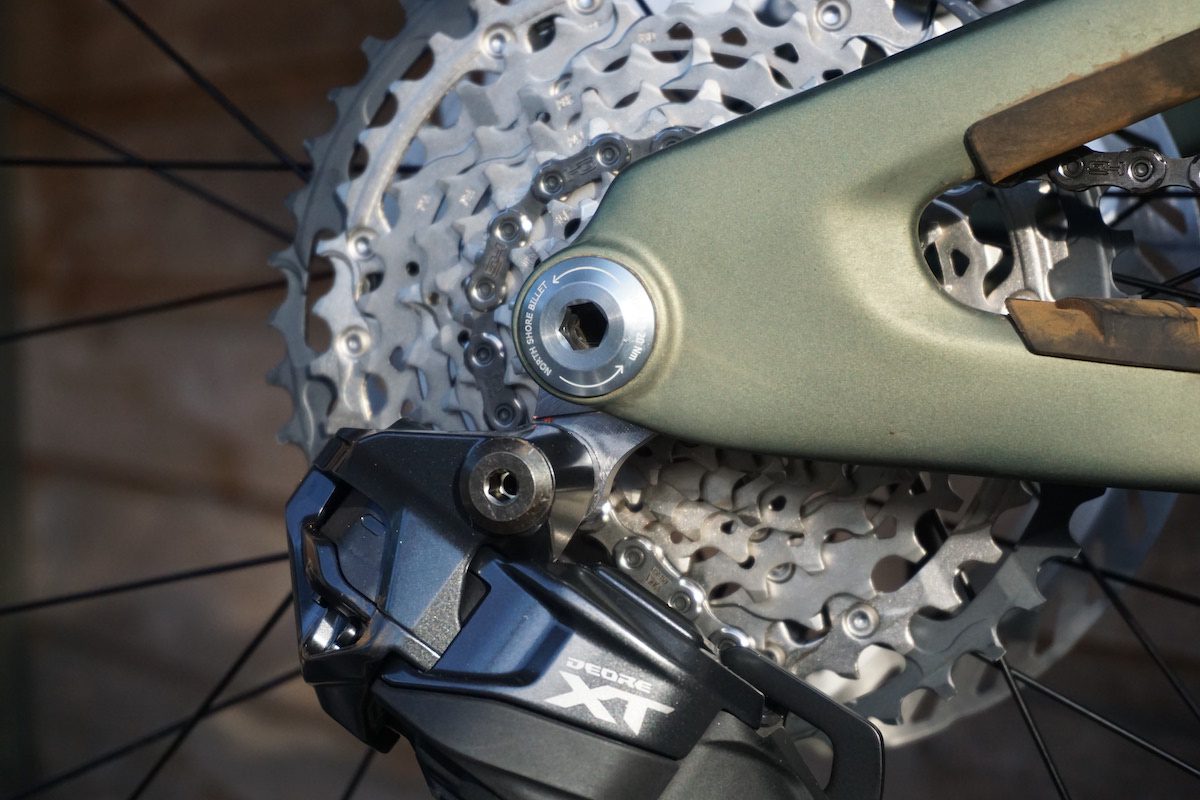Shimano’s first wireless Di2 release held a suite of surprises. Not just in the inner workings of the wireless systems, either. New brakes, wheels and what could be the sleeper hit, a new compact, 9-45 cassette.
With the 9-45, Shimano diverges from the current “bigger is better” approach gearing that’s dominated mountain biking for nearly a decade. And for a few good reasons. So, when we had the chance to test XT Di2, we also thought it’d be a great time to compare the 9-45 option with the more standard wide-range 10-51 cassette.
The results are intriguing, to say the least. The group is lighter, faster and less prone to damage. That left us wondering: are big cassettes dumb?
Little cogs, big wins
Before you write me off as some fringe lunatic, let’s be clear: I’m not the only one taking note of the new 9-45 cassette option. More pros are already starting to make the switch, even with Di2 only landing in team tents mid-season.
At 2025 cross country world championships, Alan Hatherly won the elite men’s race on the compact version of Shimano’s XTR group, then repeated that result a week later at the Leogang World Cup XCO. His Cannondale teammate Charlie Aldridge also used the group to win the Mont-Sainte-Anne World Cup XCO. Orbea’s Simon Andreassen, among others, has been spotted running the group at World Cup’s, too.
At Enduro world championships a week earlier, Richie Rude won and Canada’s Elliot Jamieson finished third. That mean’s 2/3 of the men’s podium were riding the compact version of Shimano’s wireless group.
Rainbows, World Cup wins and podiums. That’s not a bad set of results for a drivetrain that, again, only arrived mid-season.
Compact vs wide-range: Why?
This is cool, I promise. And not just for gear nerds. I know the marketing focus for, like, a decade now has focused on offering bigger cogs and incrementally wider range cassettes. The silly sequential release of 10-50t from SRAM, 10-51t from Shimano, then 10-52t from SRAM, with the single-tooth changes, was just a little too conspicuous. While both companies insist they were driven purely by engineering, the releases couldn’t have been better scripted if they’d tried. And the message was clear: when it comes to cassettes, bigger is better.
These cassettes came with downsides, though. They’re heavier, they decrease ground clearance and it takes time to get between those big cogs.
But what if there was a way to get enough range with faster shifting and lighter drivetrains? Are we ready to tip-toe ever so slightly back from “more is better” to consider other performance factors? Or do we all just want the biggest honking dinner plate we can fit on our back wheel?
I’d like to think that shifting speed and weight still matter. So I was keen to try out the short-cage version of Shimano’s XT Di2. Since our XT test group arrived, the “compact” version of Shimano’s XTR has won a few world championships, in enduro and in cross country, and earned more podiums.
Compact isn’t new. Shimano offered a 10-45t version of its mechanical XTR group before the Di2 release. But the new release gives compact performance without sacrificing range by adding a tiny, 9-tooth cog. This makes it easier to go compact than ever before. And, as mentioned, it appears to have convinced several top XC racers to switch from the 10-51 option to join the enduro racers already running the 10-45 option.
For those gravity athletes, the increased clearance was already worth the sacrifice in gearing range. For XC racers, the decreased weight and, I think, faster shifting speed makes a convincing argument to make the switch.
After riding it, I think it’s a good option for many more of us more normal riders, too.
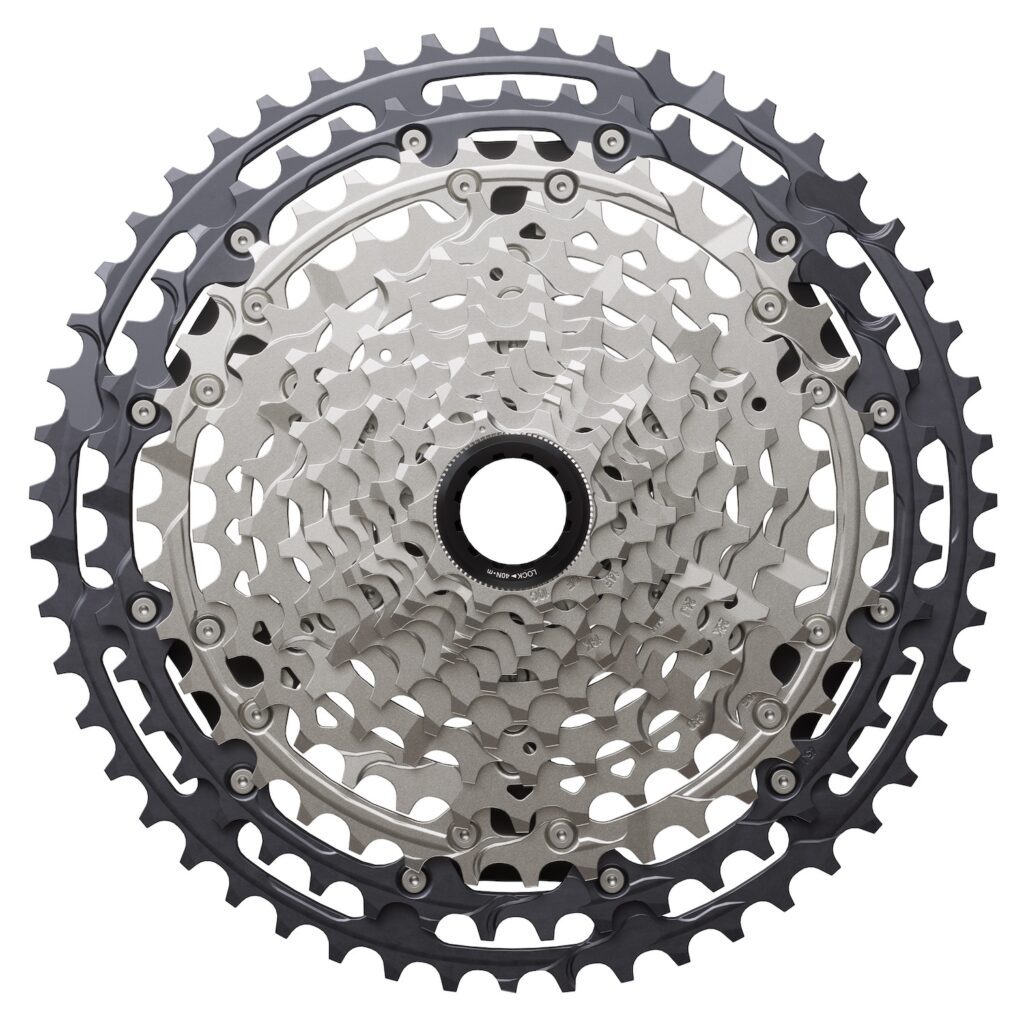 Like XTR, XT comes in standard (10-51) and …
Like XTR, XT comes in standard (10-51) and … 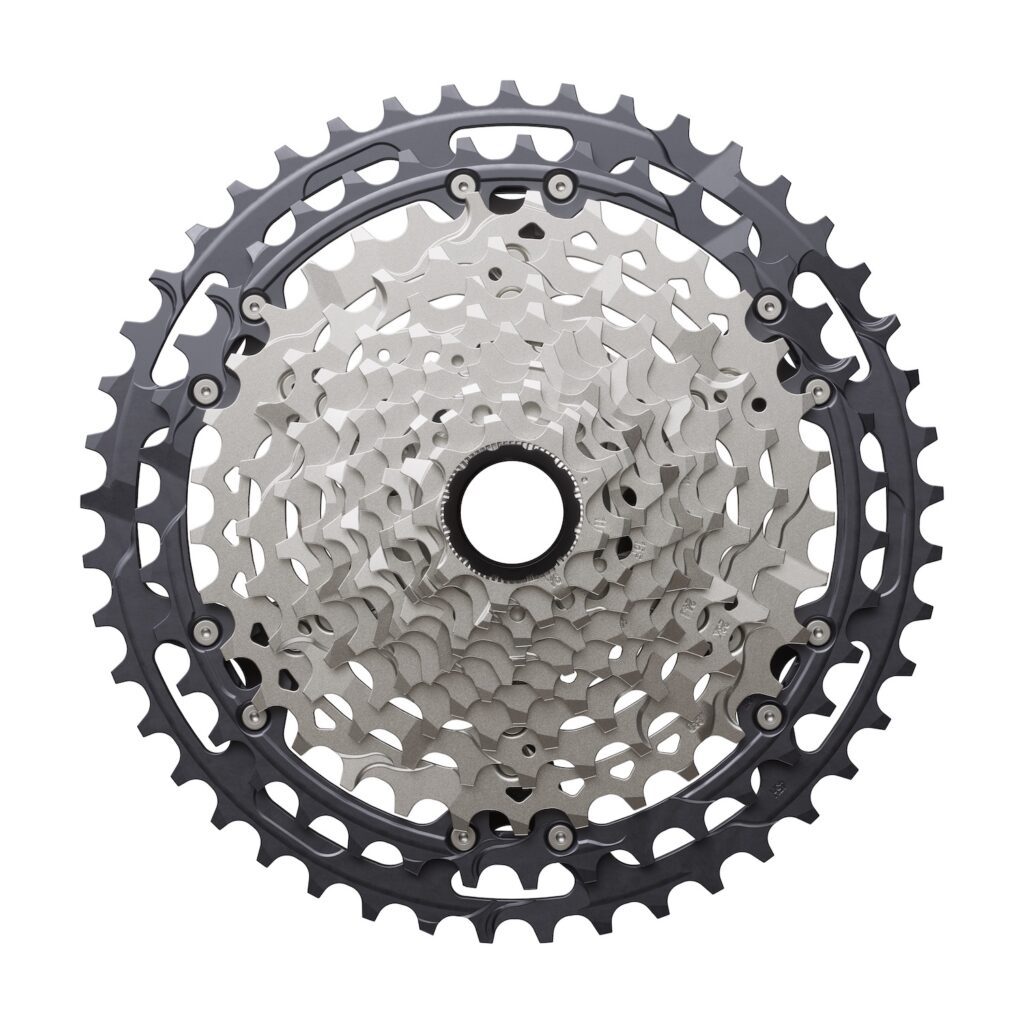 … a compact option, using a new 9-45 cassette
… a compact option, using a new 9-45 cassette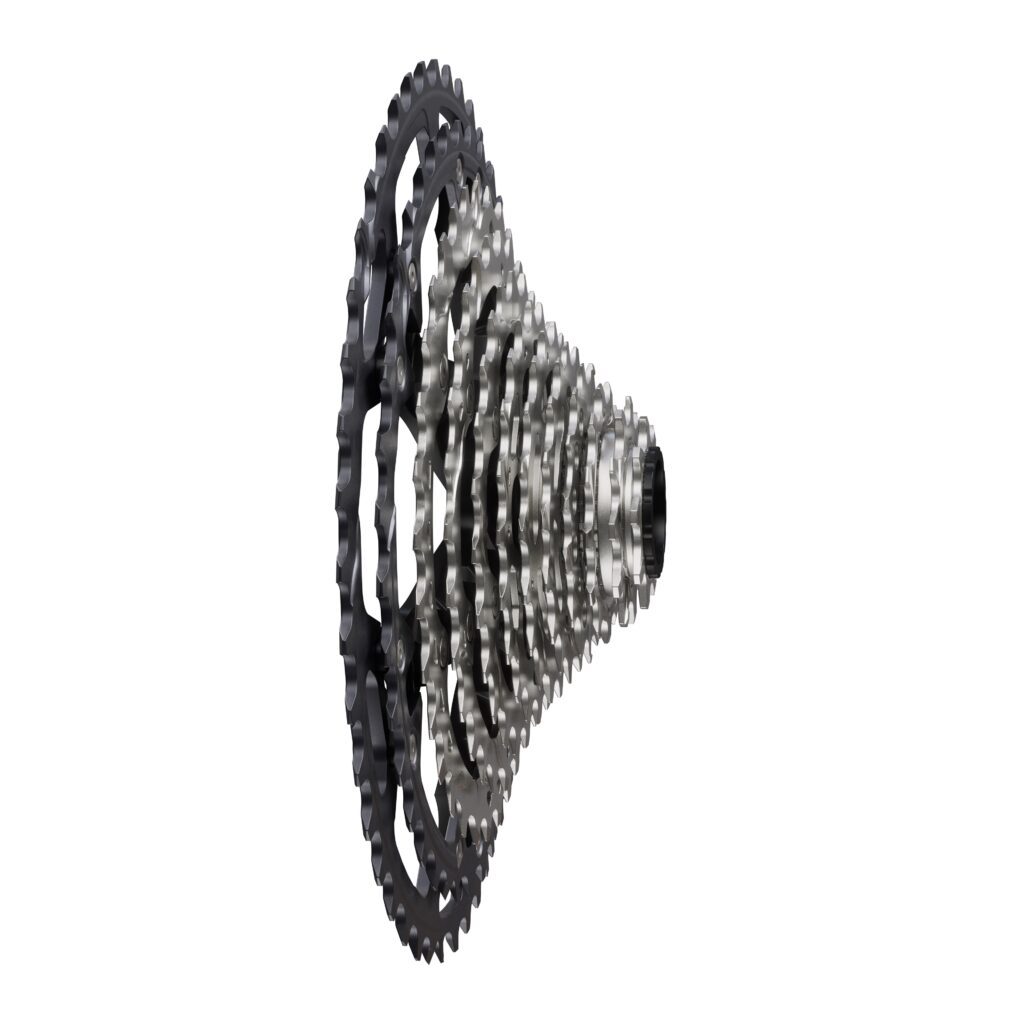 And the tighter spacing of the 9-45
And the tighter spacing of the 9-45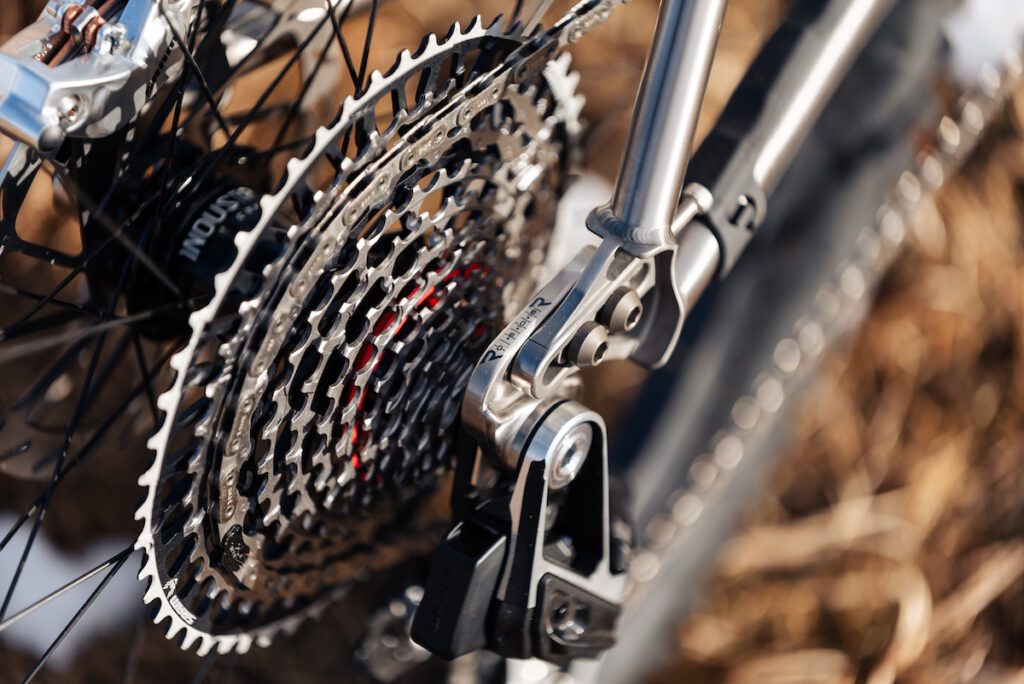 SRAM’s XX T-Type Cassette
SRAM’s XX T-Type Cassette
Compact vs. wide-range: By the numbers
There are a few imperical reasons to consider the short cage/compact option over wide-range. We’ll get deep into the numbers, first, then get into our ride impressions after that. So if gearing charts isn’t your jam, skip ahead a couple sections.
First, there’s more clearance between the rear derailleur and the ground, which can be important if you’re running a 27.5″ rear wheel. Shimano says there’s 23mm more clearance for a GS vs a SGS derailleur.
Then there’s weight. For XTR, the compact group is 70g lighter than the wide-range group. That difference is roughly the same for XT, too.
While a 70g difference may matter to the pros, I think that the change in steps between cogs will be more important to most of us. The compact group gives smaller steps between cogs further into the cassette than Shimano’s wide-range cassette. Compared to SRAM T-Type, where there’s a slightly different strategy to the gear spacing, the jumps at the end of the cassette are even more exaggerated.
Shimano 9-45 Cassette
Teeth: 9-11-13-15-17-19-21-24-28-33-39-45T (500% gear range. XT: 426g, $263)
Jumps: 2-2-2-2-2-2-3-4-5-6-6
Shimano 10-51 Cassette
Teeth: 10-12-14-16-18-21-24-28-33-39-45-51T (510% gear range. XT: 463g, $263)
Jumps: 2-2-2-2-3-3-4-5-6-6-6
That looks kind of similar, or just like a blur of numbers. But it means bigger jumps between cogs start two cogs earlier, right in the heart of the cassette.
SRAM T-Type Cassette
Teeth: 10-12-14-16-18-21-24-28-32-38-44-52T (520% gear range. XO: 385g, 583$)
Jumps: 2-2-2-2-3-3-4-4-5-5-8
All those numbers are the same from XT to XTR, though the very high-zoot titanium teeth on XTR drops their weight to 327g and 369g, respectively.
To include SRAM in this, XX SL cassettes are 360g, XO cassettes are 385g, and GX are 445g.
Shimano’s Deore Di2 uses the same M6100 cassette, which only comes in 10-51, and that is $152 for a 591g cassette.
For those keeping track at home, prices for all those options vary widely, too. It’s $263 for XT cassette, $674 for XTR. On the SRAM side of things, it’s $583 for XO T-Type. GX T-Type $365 and, for the lightweight XX SL, $874.
Compact vs wide-range: On the trail
This is the really important bit: how the compact cassette actually feels to ride. Riding the 9-45 on the trails was a quick reminder of the small sacrifices we’ve all made to get wider range cassettes. The smaller steps between gears were immediately noticeable. Especially when climbing, but also riding to and from the trails, it makes it easier to stay in that sweet spot of cadence and effort over slight changes in grade. I don’t tend to ride with a power meter, but we all know that feeling of being stuck between gears, either grinding with too much effort in one gear or spinning too easy in the next. Those gaps close significantly with the small change in cassette profile.
As I’ll get into a bit more below, I had the XT 9-45 group set up with a 30t chainring to match the easiest gearing on a 10-51 with a 34-tooth chainring. That meant that, going back and forth between those two, there was no sacrifice when hitting steeper or sustained climbs. If I’d been coming from a 32-tooth chainring, which many bikes come with nowadays, you would be in a harder gear at the easy end of the cassette. If you spend a ton of time in that cog, that’s a consideration that shouldn’t be ignored. So far, though, I’m finding the narrower steps between cogs on the compact cassette worth it.
Shimano also says 9-45 is quieter with its new non-clutch chain tensioner in the Di2 derailleurs. I don’t think I have enough time to specifically credit the compact derailleur on this front, but it does run quiet.
Cassettes determine shifting speed
Shifting the compact cassette is also faster than a standard wide-range cassette, especially shifting from the largest cogs into harder gears. Di2 is already very fast, yes, but there is a physical limit to how fast any derailleur can get from a 51- or 52-tooth to the next cog. Depending on your cadence and the situation, waiting for the chain to drop down from the 51 or 52 can feel like an eternity. Shifting out of the 45 on a compact cassette feels comparatively fast. This is incredibly important for technical climbing, where being able to grab a gear quickly to get more power can make the difference between making it up and over a feature, or having to step off the bike. For racing (or just for fun), the compact cassette also makes it quicker to pick up speed as you crest a steep climb.
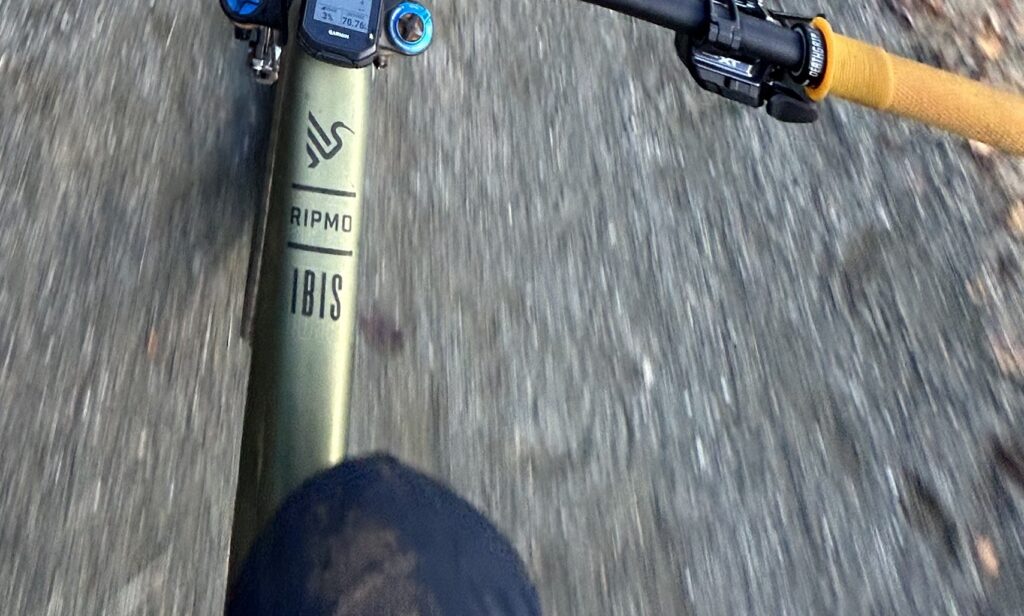 XT on the move
XT on the move  Feeling the climb
Feeling the climb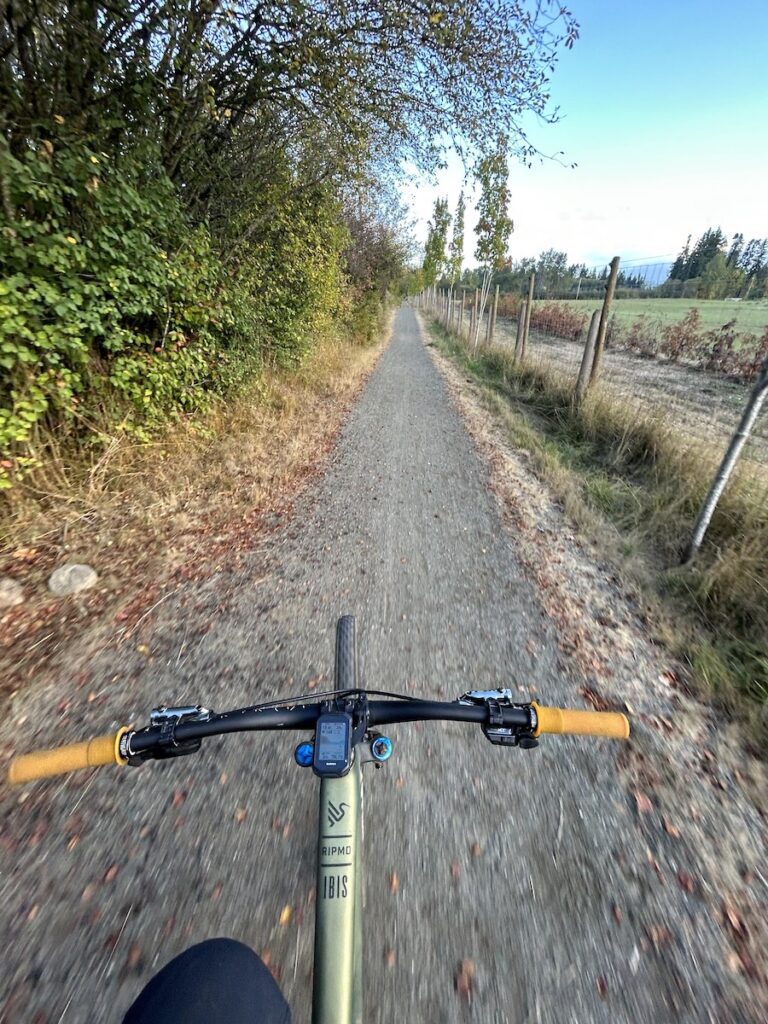 This false flat felt as as big as the 1,000m climb
This false flat felt as as big as the 1,000m climb
A little cassette, a big dumb ride
The best test for the compact cassette I could think of, beyond everyday riding, was a really big, dumb ride with a huge variety of terrain. Lots of climbing – over 1,000m – to make sure I didn’t hate the smaller cassette when it mattered most. I.e. when I was very, very tired. Lot more descending, with the help of a few chairlift bumps. A mix of trail, gravel, a few bike park laps, and some tarmac home. I rode up a silly mountain to the local bike park, then hit some trails on the road back down. It was a good combination to test of practical gearing and the only place I thought I might, with my current fitness and power, spin out a 9t cog.
I already had a bunch of rides on 9-45 at this point and liked it, but I thought this is where the spell might break. It ended up making me like the compact gearing more. The smaller shifts between gears made the long climb up feel smoother, letting me stay in a more consistent cadence range (without actually making the hill easier, of course). But, maybe more importantly, when I was totally shelled near the end of the ride, when every slight hill felt massive and even false-flats felt like mountains, the compact cassette made it easier to find a comfortable gearing.
A note on range vs actual gearing
If you’re like me, when you looked at those cassette profiles, you were probably seeing either that meme with all the floating numbers or Charlie from It’s Always Sunny. What do those numbers mean?
A lot the marketing about wide range cassettes, or at least how we read it, focuses on how the biggest cogs will make climbing easier. There’s not too much mention of how often we actually use our 10t cogs. And not much mention at all that you can get the same gearing from a 45t cog and a 51t cog, depending on the chainring. That is, you can make a 9-45 cassette just as easy to pedal uphill as a 10-51 by changing your chainring.
If you look at it in gear inches, a 30-tooth chainring with a 45-tooth (30×45 = 19.3 gear inches) cog is roughly the same as a 34-tooth chainring with a 51-tooth cog (34×51 = 19.3). A 28×45 combo is slightly easier than a 32×51 (18.0 vs. 18.2).
So, depending what chainring you run, you can get the same easy gearing by dropping four teeth at the chainring. Since the gear range isn’t identical on the compact and standard cassettes, keeping that same four-tooth difference will see a bit of a loss in the hardest gear. A 28×9 ratio is easier than a 32×10 and a 30×9 is easier than a 34×10. You can obviously do the opposite as well, and prioritise harder gearing. A 32-9 is harder than a 34-10, a 30-9 is harder than a 32-10, but you’ll lose some range at the easy end of the cassette that way.
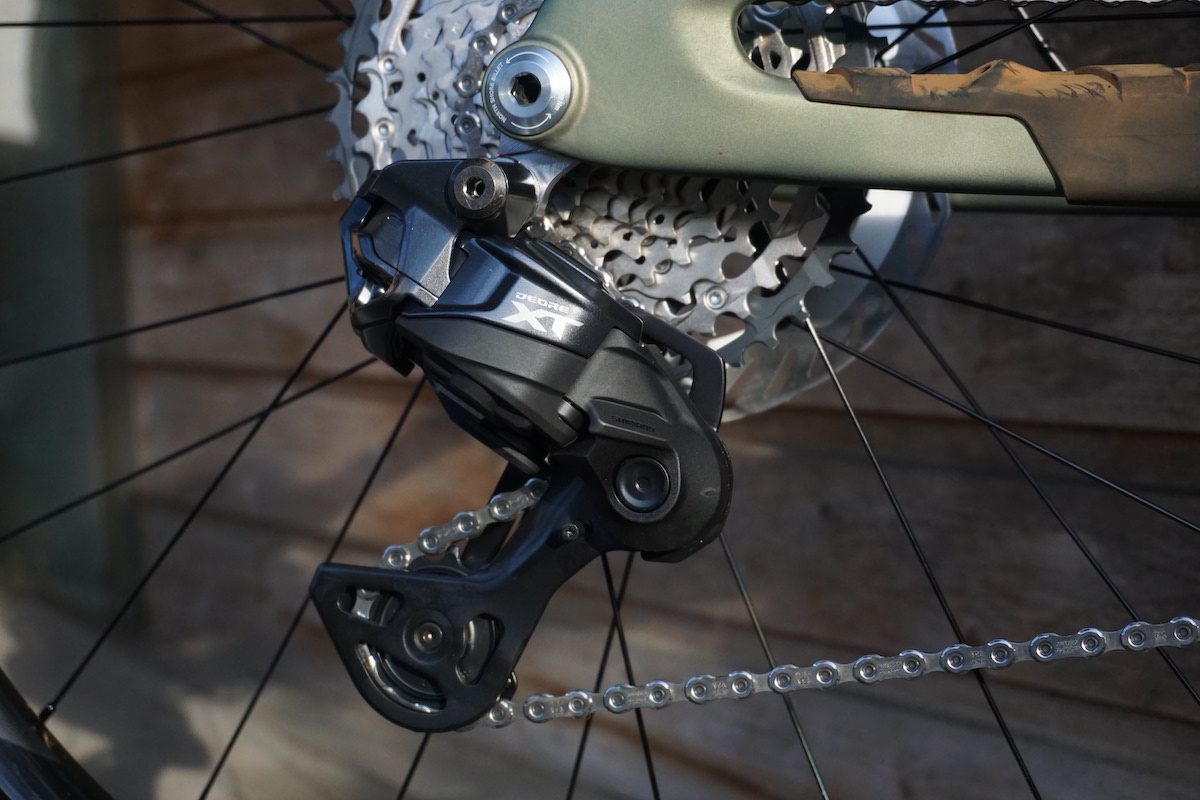 Our XT Di2 test group
Our XT Di2 test group
A note on derailleurs
While we’re here, let’s get all the numbers out of the way and cover derailleur weights. The difference between GS and SGS Shimano derailleurs is minimal: 2g for XTR and 3g for XT. Specifically, for XT that is 451g (GS) vs. 454g for long cage (SGS) and for XTR 389g and 391g.
Weights for SRAM’s T-Type rear mechs are: 440g for XX SL, 466g for XO, 470g for GX. Since those weights include the mount, you can add ~20g to the Shimano weights to account for a derailleur hanger. Do with that what you will, but those weights are pretty comparable across brands. XTR is slightly lighter than XX SL and, when you factor in a hanger, XO is slightly lighter than XT.
If you don’t care about that extra range and just want a faster shifting, lighter cassette, Shimano says the new Di2 derailleurs will work with the 10-45 cassette (and vice versa, likely, for those of you who have an HG freehub wheelset and don’t want to convert to MicroSpline but do want Di2).
Compact 9-45: Theory vs reality
The slightly narrower gear range – 500% vs 510% – does mean you have to pick your priority: top end speed or better gearing for climbing. Not by much. But there’ is a difference, and differences matter. I opted to retain easier gearing and risk losing out on a bit of speed when I’m in the 9t cog. Which is … not often. But I did test it out and I was spinning in the high 40 km/hrs, on a paved road downhill from a bike park. Having tried 10-45 on a gravel bike, only to find myself spinning to keep up on some group rides, I was legitimately concerned this might be an issue. Especially with the smaller chainring. I no longer think for mountain biking, at least for me, it’s a problem.
There could be some issues that come along with dropping to a smaller chainring, though. Lets start with frame tolerance issues. Some frames have a minimum chainring size. That’s often 28t but, for some, its 30t. So if your bike comes with a 32t chainring, you might not be able to drop down to a 28 to run a compact cassette without losing some range at both ends of the cassette. For full suspension mountain bikes, a four-tooth change in chainring size could also impact suspension performance. Some brands design their anti-squat and anti-rise characteristics around a narrow range of chainring sizes. This could lead to some small changes in suspension performance, but that is not going to significantly affect the majority of frames.
Final Word: Are big cassettes dumb?
So, are big cassettes dumb? Kind of, yeah. There are, as mentioned above, some situations where some frames won’t allow a smaller chainring and that could end up limiting a rider’s ability to get comparable easy gearing from a compact cassette to what you can get with a true, wide-range cassette. That’s not a small thing. But any time it is possible to get the full desired range of gearing from the smaller cassette, I think the smaller group is the better option.
Faster shifting out of big cogs feels great. That’s always been a frustration since wide-range 12-speed was introduced, but its also always been worth the trade-off for easier gearing. Lighter never hurts. As several mangled rear derailleurs in my parts bin will attest, more clearance is a good thing.
Getting smaller, smoother steps between gears is, I think, the biggest advantage of compact gearing. It made pedalling hard feel better in so many different scenarios, often ones where I’d forgotten why big steps between gears were annoying.
If you spend the vast majority of your time in the biggest cog you have and still wish for easier gearing, then maybe this isn’t for you. (And, side note, maybe you could also benefit from a smaller chainring). But for anyone else, I think this is a no-brainer.

